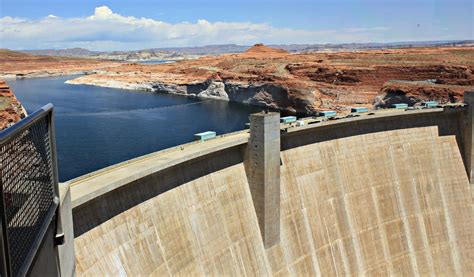The Glen Canyon Dam reservoir, known as Lake Powell, is a vast artificial lake situated in the American Southwest, primarily within the state of Utah. Created by the construction of the Glen Canyon Dam on the Colorado River, Lake Powell extends approximately 186 miles in length and covers an area of around 161,000 acres when full. Completed in 1966, the dam was built to provide water storage, hydroelectric power, and flood control, and it plays a crucial role in managing the water resources of the Colorado River Basin. Lake Powell is a popular recreational destination, offering opportunities for boating, fishing, and exploring its numerous canyons and scenic vistas. However, the reservoir has faced significant challenges, including fluctuating water levels and environmental concerns, which have impacted its ecological health and the surrounding landscape. There are many additional facts about Lake Powell that highlight its significance, challenges, and the role it plays in water management and recreation.

Construction and Purpose
The construction of the Glen Canyon Dam and the creation of Lake Powell were major engineering feats that had profound impacts on the region. The dam, built by the Bureau of Reclamation, was completed in 1966 after nearly a decade of construction. It stands 710 feet tall and spans 1,560 feet across the Colorado River, making it one of the largest concrete dams in the United States. The primary purposes of the dam are to provide water storage for agricultural and municipal use, generate hydroelectric power, and offer flood control. Lake Powell serves as a crucial reservoir in the Colorado River Basin, helping to regulate the flow of water downstream and ensure a reliable supply for millions of users across several states. Additionally, the hydroelectric power generated by the dam contributes to the regional electricity grid, providing renewable energy to a large population. The creation of Lake Powell transformed the landscape, submerging Glen Canyon and creating a new, expansive body of water that has become a key component of the region’s water management system.
Recreational Activities and Popularity
Lake Powell has become a renowned destination for recreational activities, attracting visitors from around the world. Its expansive size and stunning natural scenery make it an ideal location for boating, fishing, and water sports. The reservoir’s numerous canyons, such as Rainbow Bridge and Antelope Canyon, offer opportunities for exploration and sightseeing, and the lake’s clear blue waters provide a striking contrast to the surrounding red rock landscape. Visitors can enjoy house boating, kayaking, and paddleboarding on the lake, with many people opting to rent houseboats for extended stays on the water. Fishing is also a popular activity, with species such as bass, walleye, and catfish found in the lake. The accessibility of the lake from major cities and its diverse recreational offerings contribute to its popularity as a vacation destination. The combination of natural beauty and recreational opportunities makes Lake Powell a cherished spot for outdoor enthusiasts and families alike.
Environmental Concerns and Water Levels
Despite its popularity, Lake Powell has faced significant environmental concerns, particularly related to fluctuating water levels and ecological impacts. The reservoir’s water levels have experienced dramatic variations over the years due to factors such as drought, changing precipitation patterns, and increased water demand. These fluctuations can impact the reservoir’s ability to provide reliable water storage and hydroelectric power, as well as affect the health of the surrounding ecosystem. Lower water levels can expose previously submerged areas, altering habitats and affecting wildlife. Additionally, the creation of Lake Powell and the Glen Canyon Dam has led to the loss of the Glen Canyon environment, which was once a vibrant and ecologically rich area. Efforts to manage the environmental impacts include monitoring water quality, studying the effects of fluctuating water levels on ecosystems, and implementing conservation measures. Addressing these concerns is crucial for balancing the needs of water management with the preservation of the natural environment.
Impact on Local Communities and Culture
The creation of Lake Powell and the Glen Canyon Dam has had a significant impact on local communities and cultural heritage. Before the construction of the dam, the Glen Canyon area was home to a variety of cultural and historical sites, including Native American sites and early settler communities. The flooding caused by the reservoir submerged many of these sites, leading to the loss of valuable archaeological and cultural resources. The Navajo Nation, along with other indigenous groups, has expressed concerns about the impact of the dam on their heritage and traditional lands. Additionally, the changes brought about by the creation of Lake Powell have influenced the local economy and lifestyle, with the area becoming more focused on tourism and recreation. While the dam and reservoir have provided benefits such as water storage and power generation, the cultural and historical implications of their construction continue to be a point of discussion and reflection for those affected by the changes.
Future Challenges and Management
Looking ahead, Lake Powell faces several challenges related to water management, environmental sustainability, and infrastructure. As climate change and prolonged droughts affect the Colorado River Basin, the reservoir’s ability to maintain adequate water levels and fulfill its roles in water storage and power generation may be compromised. The management of Lake Powell requires careful balancing of water resources to meet the needs of agriculture, municipalities, and power production while addressing ecological concerns. Ongoing efforts to address these challenges include improving water conservation practices, enhancing the efficiency of water use, and exploring potential modifications to the reservoir’s operation. Additionally, there is a growing focus on sustainable management practices that consider the long-term impacts on the environment and local communities. The future of Lake Powell will depend on the ability to adapt to changing conditions and to implement strategies that support both human and ecological needs. Ensuring the continued viability of this important reservoir will require collaboration and innovation in water resource management and environmental stewardship.